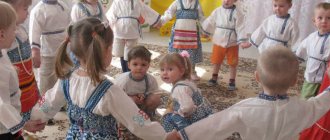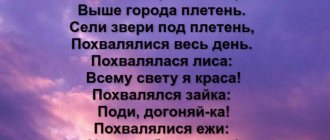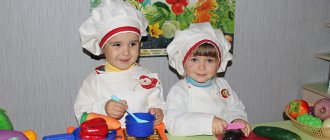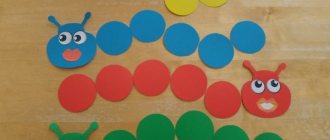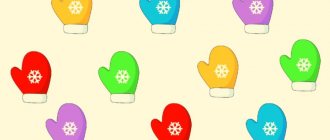Round dance games in the activities of preschoolers: features and significance
Currently, there is great attention to national culture and art. The spiritual and moral education of the younger generation is carried out through the constant study of folklore, folk crafts and traditions. Round dance games have gained popularity in working with preschoolers for a reason. Round dance is the oldest type of dance. He accompanied the Slavs in various life situations: during ritual processions, field work, wedding festivities, etc.
Russian round dance has long been not just a dance, it is a way of life
How do round dance games benefit children's development?
- The very formation of a round dance - a circle - educates the children. Placing participants at equal distances from the center creates a feeling of equality. In a round dance chain, each child understands the importance of moving to the beat of the music, in accordance with the rules. Everyone is responsible for the integrity of the round dance; this game helps to organize the group.
- Round dance games are musical and rhythmic. Children move in a circle and make additional movements to the beat of the music. Sound perception and coordination of movements develops.
- In round dance games, movements are combined with song and musical accompaniment. By older preschool age, children sing songs independently. In this way, performance skills are developed.
- The content of round dance songs introduces children to folk culture. The guys are immersed in the melodiousness of slow melodies, frolicking to funny songs. Folklore songs instill moral qualities in children: love for their native land and wildlife, the desire for good.
Round dance makes children feel that each of them is an important part of the team.
Traditional games, round dances and fun on Great Day
The purpose of holding round dance games in kindergarten is the harmonious development of children through familiarization with folk traditions. Teaching dance games is based on the principle “from simple to complex.” Children should experience positive emotions, therefore, in each age group, round dances are organized taking into account the characteristics of the children.
Table: card index of round dance games in kindergarten
| Group | Round dance games | What are the benefits for this age group? |
| Nursery (first junior) | "Inflate, bubble." Children walk in a circle holding hands. First, the teacher speaks the poetic text, then the children learn and pronounce the words in chorus. When the word “burst” sounds, the children break the chain, squat down and exhale: “Sh-sh-sh-sh...” A more complicated version: children walk in a circle, then it swells and bursts. "Legs." The children walk in a circle slowly, loudly stamping their feet: “Big feet walked along the road.” Then quickly and in small steps: “Little feet walked along the path.” "Carousel". Song accompaniment: “Barely, barely, barely the carousel turned.” In the center of the round dance there is a column with ribbons or a teacher with long ribbons attached to his belt. The song plays, the children hold on to the ends of the ribbons and spin the carousel at an ever-accelerating pace (according to the words of the song), then spin the ribbons in the opposite direction. | The games have simple song content, children are not distracted by the words. The round dance game develops children's coordination of movements and the ability to repeat. |
| Junior (second) | “The cat went to the stove.” Song accompaniment: “The cat went to the stove, found a pot of porridge.” Children lead a round dance, in the center of which the teacher, in the role of a cat, performs a song and acts out a role. This game is played in middle and senior groups with one of the children playing the role of a cat. "Matryoshka" Song: “And how clean our palms are.” Children walk in a circle and, together with the teacher, pronounce the words of the song and perform the movements described in the text. “We are walking through the forest.” To the words of the song of the same name. Children walk in a circle, saying which wild animal they call. "Circle". Children lead a round dance, saying: “Circle, circle, small step. One, two, three, turn around too!” The leader calls the name of the child, he turns, the round dance movement resumes, the name of the next child is called, etc. | In the song accompaniment of the games, words and lines are repeated, the children try to sing along with the teacher. Memory develops: children learn a song and sing in chorus. The game develops auditory attention: children respond to their name and complete tasks based on the lyrics of the song. |
| Average | "Zucchini"/"Cap". Song accompaniment: “Zucchini, zucchini - thin legs.” Children dance around the zucchini. After the song is performed by the round dance participants, the “zucchini” performs an impromptu dance and changes roles with another child. "Mice and Babies"/"Cat and Mouse". Song: “Oh, how tired the mice are!” Children are divided into two teams (mice and children/cats). Children form a circle, holding hands, raising them up. Mice run through the resulting gates while the song plays. When the song is over, the gate hands are lowered; whoever remains inside the circle is caught from the mice. "Bear". Song: “Like snow, snow under a hill.” Children dance in a round dance, now approaching and then moving away from the “bear” - a child who sits on a chair in the center of the round dance with his eyes closed. The last words of the song are spoken only by one of the participants, whose voice the “bear” must guess. "The mice dance in circles." To the words of the song of the same name. The presenter is selected, he sits on a chair in. At the last words of the song, the round dance falls apart, the leader tries to catch one of the guys. This game is often played in younger groups, the role of the leader and the song is performed by the teacher. "Teremok". Song: “There is a teremok in the field, a teremok.” Among the participants, those playing the roles of animals from the tower are selected. The children lead a round dance and sing a song, the “little animal” that is sung about in the verse runs along the circle. | Movement in a round dance becomes more difficult. The circular formation often breaks down in games with middle preschoolers. Games rapidly develop motor abilities: reaction speed, dexterity. |
| Senior and preparatory | "Thread"/"Thread with a needle." Children stand in a chain. The first and second participants raise their hands, creating a hoop or eye of a needle into which the “needle” (the opposite end of the chain) should fall. "Dudar." Song: "Dudar, dudar, dudarishche." The presenter is in the center of the circle and answers the song question about what hurts him. After this, the round dance participants start the song again, holding on to the place that the dudar named. "Cabbage" Song: “Oh, cabbage, my seedlings!” The children practice twisting and unwinding the spiral in a round dance movement. "Wattle" Song: “We walk around the birch tree.” Children line up in a chain, facing in one direction, holding a long rope. When the song ends, the leader leads a round dance with a snake at a fast pace. Whoever fails to stay on his feet is eliminated. “Burners” / “Burn, burn clearly.” To the words of the song of the same name. A round dance chain is formed by pairs of participants lined up in a row. In front of the column is the leader - the burner. At the end of the song, the last pair of participants runs to the beginning of the chain, and the burner tries to hit one of the runners. "Candy wrappers." In the center of the round dance there is a leader, the guys agree with their eyes who will be the guesser. The presenter says: “Santa wrappers, limpopo!” The participants in the round dance repeat the movements after the wisher; he changes them quite often. The presenter tries to guess who the guys chose. "Handkerchief." A leader is chosen for the game - a peddler. Children dance in a circle, squat and close their eyes. The peddler covers one of the guys with a handkerchief. When the children open their eyes, the peddler asks who will come to the handkerchief and name the person hidden under it. | For older preschoolers, round dance games have complicated rules. The participants in the games act in collusion. The presenter shows ingenuity and dexterity. Children practice performing round dance patterns (snail, snake), thus expanding their spatial understanding. |
Carousel
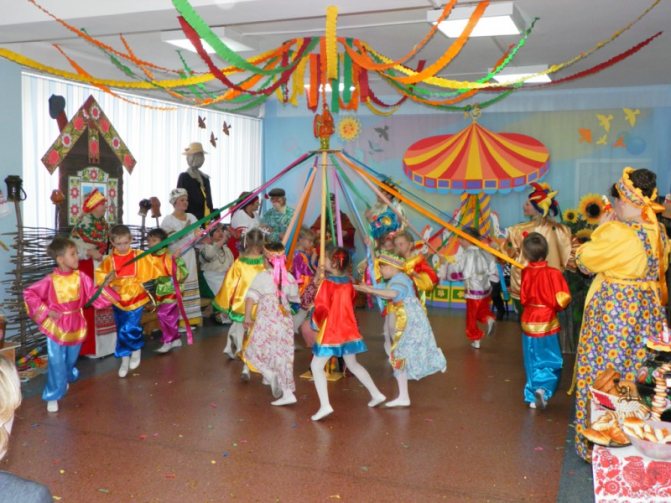
The players stand in a circle. There is a rope lying on the ground, forming a ring (the ends of the rope are tied). The guys pick it up from the ground and, holding it with their right (or left) hand, walk in a circle saying:
Barely, barely, barely The carousel spun, and then around, And then around and around, All running, running, running.
Children move slowly at first, and after the words “run” they run. At the leader’s command “Turn!” they quickly take the rope with their other hand and run in the opposite direction.
Hush, hush, don't rush! Stop the carousel. One and two, one and two, The game is over!
The movement of the carousel gradually slows down and stops with the last words. The players put the rope on the ground and run around the court.
How to conduct the outdoor game “Loaf” at a children’s birthday
Hen and chicks
Children, under the guidance of a teacher, place chairs at one end of the playroom. The number of chairs must correspond to the number of participants in the game. A cat driver is selected. The teacher acts as a mother chicken. The rest of the participants are her chicken children.
Mother hen invites all her chicks to join hands. Together they walk in a circle and say the following words:
A crested hen came out, Yellow chicks were with her, The hen clucked: ko-ko, Don’t go far.
The hen and chicks gradually approach the cat, sitting on a separate chair.
On a bench by the path a cat lay down and dozed. The cat opens its eyes and catches up with the chickens.
After these words, the chickens scatter, each trying to take his own chair. Mother chicken is worried about them, flapping her wings. The caught chicken becomes a cat. The game restarts from the beginning.
On the topic: methodological developments, presentations and notes
Round dance games and round dances of all ages are collected here.
Goal: to teach how to move slowly, repeat the movements of an adult, without breaking the chain. The adult starts the game.
Games with children give positive emotions, develop imagination and intellectual abilities. They facilitate the adaptation of children in groups. Children gain new experiences, develop social skills.
Games with children give positive emotions, develop imagination and intellectual abilities. They facilitate the adaptation of children in groups. Children gain new experiences, develop social, emotional, physical skills.
Working in kindergarten for more than 20 years, I noticed that round dance games are almost forgotten. Sometimes they occur in music classes and very rarely in the everyday life of the kindergarten. He will educate many.
ACCOMPANYING THE PRESENTATION: 1st slide. GAME is the main activity of a preschooler, necessary for the comprehensive development of personality and intelligence. Along with the overall impact of the game on the entire course of psi.
A small seminar for parents on the benefits of games.
Source
